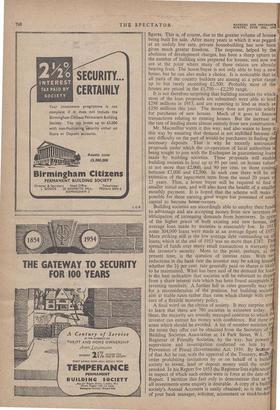; Investment in a Building figures. This is, of course, due
to the greater volume of houses , being built for sale. After many years in which it was pegged at an unduly low rate, private housebuilding has, now been '4 given much greater freedom. The response, helped by the abolition of development charges, has been a sharp upturn in the number of building sites prepared for houses; and now we are at the point where many of these estates are already bearing fruit. The house buyer is not only able to buy a new house, but he can also make a choice. It is noticeable that in all parts of the country builders are aiming at a price range up to but rarely exceeding £2,500. Probably most of the houses are priced in the £1,750 — £2,250 range. It is not therefore surprising that building societies (to which most of the loan proposals are submitted) were able to lend £298 millions in 1953, and are expecting to lend as much as £350 millions this year. The money does not provide solely for purchases of new houses. Much of it goes to finance transactions relating to existing houses. But the increase in the rate of lending stems almost entirely from new construction. Mr. Macmillan wants it this way, and also wants to keep it this way by ensuring that demand is not stultified because of any difficulty on the part of would-be purchasers in finding th necessary deposits. That is why he recently announce proposals under which the co-operation of local authorities being sought to join with the Exchequer in guaranteeing loan made by building societies. These proposals will enable building societies to lend up to 95 per cent. on houses valued' at not more than £2,000, and 90 per cent. on those costing' between £2,000 and £2,500. In each case there will be an extension of the repayment term from the usual 20 years to 25 years. Thus, a house buyer will be required to find 3 smaller initial sum, and will also have the benefit of a smaller monthly payment. It is hoped that the scheme will make it possible for those earning good wages but possessed of smal capital to become home-owners.
Building societies are accordingly able to employ their fund to advantage and are accepting money from new investors 1 anticipation of increasing demands from borrowers. In spite of the higher prices of both existing and new houses, th average loan made by societies is reasonably low. In 195 some 304,000 loans were made at an average figure of £977 More striking still is the low average ,debt outstanding on al loans, which at the end of 1953 was no more than £787. Thi spread of funds over many small transactions is warranty fo the investor's security. More to the point, perhaps, at th present time, is the question of interest rates, With tw reductions in the bank rate the investor may be asking himsel whether the 24 per cent. rate generally paid on shares is likely to be maintained. What has been said of the demand for loatO Is the best indication that societies will be reluctant to depar from a share interest rate which has been found acceptable hi investing members. A further fall in rates generally may cal for a reconsideration of the position, but building societie aim at stable rates rather than rates which change with ever turn of a flexible monetary policy.
A final word on the choice of society. It may surprise soli to learn that there are 780 societies in existence today. these, the majority are soundly managed concerns to which till investor can entrust his money with confidence. But there ar some which should be avoided. A list of member societies arl` the terms they offer can be obtained from the Secretary of tl Building Societies Association at 14 Park Street, W.1. Ti Registrar of Friendly Societies, by the way, has powers supervision and investigation conferred on him by Prevention of Fraud (Investments) Act, 1939. By Section of that Act he can, with the approval of the Treasury, irtiN order prohibiting invitations by or on behalf of a buil society to invest, lend or deposit money until the ordet revoked. In his Report for 1953 the Registrar lists eight soci in respect of which such orders were in force at the date of Report. I 'mention this fact only to demonstrate that as all investments some enquiry is desirable. A copy of a buil society's Annual Accounts is easily obtained; so is the ad of your bank manager, solicitor, accountant or stockbrok



















































 Previous page
Previous page